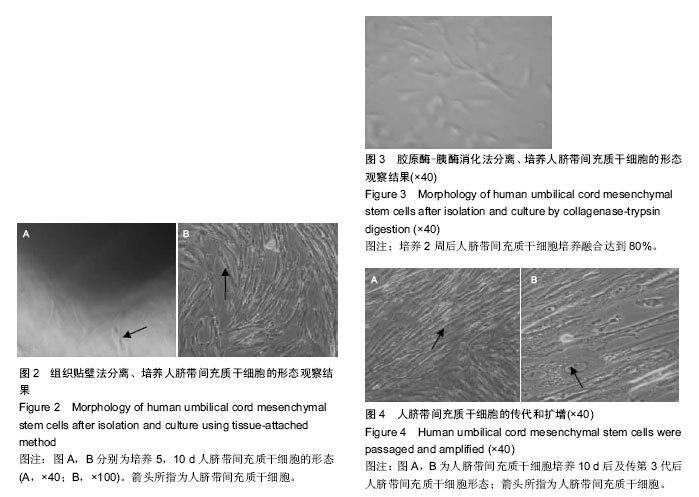| [1] Fong CY, Peh GS, Gauthaman K, et al. Separation of SSEA-4 and TRA-1-60 labelled undifferentiated human embryonic stem cells from a heterogeneous cell population using magnetic-activated cell sorting (MACS) and fluorescence-activated cell sorting (FACS). Stem Cell Rev. 2009;5(1):72-80.
[2] Chang Y, Hsieh PH, Chao CC. The efficiency of Percoll and Ficoll density gradient media in the isolation of marrow derived human mesenchymal stem cells with osteogenic potential. Chang Gung Med J. 2009; 32(3): 264-275.
[3] Lee KS, Nah JJ, Lee BC, et al. Maintenance and characterization of multipotent isolated from canine umbilical cord matrix by collagenase digestion. Res Vet Sci. 2013;94(1):144-151.
[4] 邓近平,戴钟铨,刘收,等.红细胞裂解法分离及培养大鼠骨髓间充质干细胞[J].中国组织工程研究与临床康复,2007, 11(3):579-582.
[5] 张卫东,章方彪,史宏灿,等.红细胞裂解液法体外分离培养兔骨髓间充质干细胞[J].中国组织工程研究,2013,17(49): 8468-8473.
[6] 林春博,杨渊,陈维平.低渗结合自然沉降法分离兔骨髓间充质干细胞及其鉴定[J].中国组织工程研究与临床康复, 2011,15(1):12-16.
[7] 杨辉,蔡光先,刘柏炎,等.首次换液时间对贴壁法培养骨髓间充质干细胞纯度及增殖的影响[J].中国组织工程研究与临床康复,2007,11(20):3868-3871.
[8] Lindsay SL, Johnstone SA, Mountford JC, et al. Human mesenchymal stem cells isolated from olfactory biopsies but not bone enhance CNS myelination in vitro. Glia. 2013,61(3):368-382.
[9] 陆琰,陈丽,张洹.人胎盘间充质干细胞4种消化分离方法的效果比较[J].中国组织工程研究与临床康复,2009, 13(6):1017-1020.
[10] 肖盼,陈剑,王彦平,等.不同消化分离方法分离人羊膜间充质干细胞效果比较[J].中国病理生理杂志,2010,26(5): 1033-1037.
[11] Ghorbani A, Jalali SA, Varedi M. Isolation of adipose tissue mesenchymal stem cells without tissue destruction: a non-enzymatic method. Tissue Cell. 2014;46(1):54-58.
[12] Grisendi G, Annerén C, Cafarelli L, et al. GMP-manufactured density gradient media for optimized mesenchymal stromal/ stem cell isolation and expansion. Cytotherapy. 2010;12(4):466-477.
[13] Rosca AM, Burlacu A.Isolation of a mouse bone marrow population enriched in stem and progenitor cells by centrifugation on a Percoll gradient.Biotechnol Appl Biochem. 2010;55(4):199-208.
[14] 徐鹏,舒畅,赵子义,等.免疫磁珠法分离纯化骨髓间充质干细胞及向神经细胞定向分化[J].中国组织工程研究与临床康复,2007,11(20):3872-3875.
[15] 韩圣,夏照帆,韦多,等.应用免疫磁珠负选法分离与纯化小鼠骨髓间充质干细胞[J].中国临床康复,2006,10(41): 28-30.
[16] 牛微,杨曌,尚小云,等.免疫磁珠法分离人外周血CD4+ CD25+调节性T细胞[J].免疫学杂志,2007,23(4):449-451, 455.
[17] 舒赛男,魏来,方峰,等.免疫磁珠分选系统在分离大鼠骨髓干细胞群中的应用[J].标记免疫分析与临床,2006,13(1): 35-37.
[18] 杨宁,王文秀,赫文,等.免疫磁珠技术检测胃癌患者腹腔微小转移的研究[J].哈尔滨医科大学学报, 2006,40(6): 486-488.
[19] Liu QH, Ge J, Liu KY. Are CD133 and CD271 useful in positive selection to enrich umbilical cord blood mesenchymal stem cells. Zhongguo Shi Yan Xue Ye Xue Za Zhi. 2010;18(5):1286-1291.
[20] Rada T, Reis RL, Gomes ME. Distinct stem cells subpopulations isolated from human adipose tissue exhibit different chondrogenic and osteogenic differentiation potential. Stem Cell Rev. 2011;7(1): 64-76.
[21] 张科伟,刘国津,范志民,等.乳腺干细胞的体外培养及免疫磁珠法分离[J].中国组织工程研究与临床康复,2008, 12(8):1497-1500.
[22] Battula VL, Treml S, Bareiss PM, et al. Isolation of functionally distinct mesenchymal stem cell subsets using antibodies against CD56, CD271, and mesenchymal stem cell antigen-1. Haematologica. 2009;94(2):173-184.
[23] Xing W, Pang AM, Yao JF, et al. Efficient isolation of mesenchymal stem cells from human bone marrow by direct plating method combined with modified primary explant culture. Zhongguo Shi Yan Xue Ye Xue Za Zhi. 2013;21(2):451-454.
[24] 曾瑞霞,单伟,房艳,等.密度梯度离心法结合贴壁法体外分离培养大鼠骨髓间充质干细胞[J].解剖科学进展,2012, 18(5):438-441.
[25] 王英慧,郑瑞,陈莉.密度梯度离心及贴壁分离筛选相结合分离培养大鼠骨髓间充质干细胞[J].中国组织工程研究, 2014,18(28):4463-4468.
[26] 马锡慧,冯凯,石炳毅.人脐带间充质干细胞生物学特性及其研究进展[J].中国组织工程研究,2011,15(32): 6064-6067.
[27] Baksh D, Yao R, Tuan RS. Comparison of proliferative and multilineage differentiation potential of human mesenchymal stem cells derived from umbilical cord and bone marrow. Stem Cells. 2007;25(6):1384-1392.
[28] 唐欣,王岩,易海波,等.人脐带间充质干细胞诱导分化为心肌细胞的特异性基因表达[J].中国组织工程研究,2013, 17(27):4988-4991.
[29] Karnieli O, Izhar-Prato Y, Bulvik S, et al. Generation of insulin-producing cells from human bone marrow mesenchymal stem cells by genetic manipulation. Stem Cells. 2007;25(11):2837-2844.
[30] Lhle M, Hermann A, Gla H, et al. Differentiation efficiency of induced pluripotent stem cells depends on the number of reprogramming factors. Stem Cells. 2012;30(3):570-579.
[31] Gifford Casey A, Ziller Michael J, Gu H, et al. Transcriptional and epigenetic dynamics during specification of human embryonic stem cells. Cell. 2013;153(5):1149-1163.
[32] Sanchez-Adams J, Athanasiou KA. Dermis isolated adult stem cells for cartilage tissue engineering. Biomaterials. 2012;33(1):109-119.
[33] Jung Y, Bauer G, Nolta JA. Concise review: induced pluripotent stem cell-derived mesenchymal stem cells:progress toward safe clinical products. Stem Cells. 2012;30(1):42-47.
[34] Hao L, Sun HQ, Guo XS, et al. Exogenous gene expression in vitro and in vivo in bone marrow mesenchymal stem cells modified by hPDGF-A and hBD(2). Zhongguo Shi Yan Xue Ye Xue Za Zhi. 2009; 17(3):685-689.
[35] 齐凯,董丽媛,陈显久,等.人脐带来源间充质干细胞分离培养方法的优化[J].中国组织工程研究与临床康复,2011, 15(23):4220-4224.
[36] 徐燕,李长虹,孟恒星,等.人脐带间充质干细胞分离培养条件的优化及其生物学特性[J].中国组织工程研究与临床康复,2009,13(32):6289-6294.
[37] 庞荣清,何洁,李福兵,等.一种简单的人脐带间充质干细胞分离培养方法[J].中华细胞与干细胞杂志(电子版),2011, 1(2):30-33.
[38] Schmidt H, Rathjen FG. DiI-labeling of DRG neurons to study axonal branching in a whole mount preparation of mouse embryonic spinal cord. J Vis Exp. 2011;(58): 3667.
[39] Liu Y, Xue M. Recombinant human insulin gene lentivirus transfecting human umbilical cord mesenchymal stem cells in vitro. Zhongguo Xiu Fu Chong Jian Wai Ke Za Zhi. 2010;24(7):822-827.
[40] Tang L, Chang J. Effect of GFP-containing lentivirus infection on the expression of octamer transcription factor 4 in human umbilical cord mesenchymal stem cells. Xi Bao Yu Fen Zi Mian Yi Xue Za Zhi. 2013; 29(3):292-296. |
.jpg)

.jpg)
.jpg)